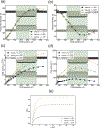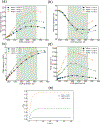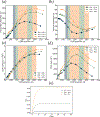Coarse-grained molecular simulation of extracellular vesicle squeezing for drug loading
- PMID: 37082907
- PMCID: PMC10337604
- DOI: 10.1039/d3cp00387f
Coarse-grained molecular simulation of extracellular vesicle squeezing for drug loading
Abstract
In recent years, extracellular vesicles have become promising carriers as next-generation drug delivery platforms. Effective loading of exogenous cargos without compromising the extracellular vesicle membrane is a major challenge. Rapid squeezing through nanofluidic channels is a widely used approach to load exogenous cargoes into the EV through the nanopores generated temporarily on the membrane. However, the exact mechanism and dynamics of nanopore opening, as well as cargo loading through nanopores during the squeezing process remains unknown and it is impossible to visualize or quantify it experimentally due to the small size of the EV and the fast transient process. This paper developed a systemic algorithm to simulate nanopore formation and predict drug loading during extracellular vesicle (EV) squeezing by leveraging the power of coarse-grain (CG) molecular dynamics simulations with fluid dynamics. The EV CG beads are coupled with implicit the fluctuating lattice Boltzmann solvent. The effects of EV properties and various squeezing test parameters, such as EV size, flow velocity, channel width, and length, on pore formation and drug loading efficiency are analyzed. Based on the simulation results, a phase diagram is provided as a design guide for nanochannel geometry and squeezing velocity to generate pores on the membrane without damaging the EV. This method can be utilized to optimize the nanofluidic device configuration and flow setup to obtain desired drug loading into EVs.
Conflict of interest statement
Conflict of Interest:
The authors declare no competing financial interest
Figures














Similar articles
-
Numerical simulation of intracellular drug delivery via rapid squeezing.Biomicrofluidics. 2021 Aug 2;15(4):044102. doi: 10.1063/5.0059165. eCollection 2021 Jul. Biomicrofluidics. 2021. PMID: 34367404 Free PMC article.
-
Quantification of protein cargo loading into engineered extracellular vesicles at single-vesicle and single-molecule resolution.J Extracell Vesicles. 2021 Aug;10(10):e12130. doi: 10.1002/jev2.12130. Epub 2021 Aug 2. J Extracell Vesicles. 2021. PMID: 34377376 Free PMC article.
-
Standardization Approaches for Extracellular Vesicle Loading with Oligonucleotides and Biologics.Small. 2023 Oct;19(40):e2301763. doi: 10.1002/smll.202301763. Epub 2023 Jun 7. Small. 2023. PMID: 37287374 Review.
-
Virus-Free Method to Control and Enhance Extracellular Vesicle Cargo Loading and Delivery.ACS Appl Bio Mater. 2023 Mar 20;6(3):1081-1091. doi: 10.1021/acsabm.2c00955. Epub 2023 Feb 13. ACS Appl Bio Mater. 2023. PMID: 36781171 Free PMC article.
-
Translating extracellular vesicle packaging into therapeutic applications.Front Immunol. 2022 Aug 15;13:946422. doi: 10.3389/fimmu.2022.946422. eCollection 2022. Front Immunol. 2022. PMID: 36045692 Free PMC article. Review.
Cited by
-
MIML: Multiplex Image Machine Learning for High Precision Cell Classification via Mechanical Traits within Microfluidic Systems.ArXiv [Preprint]. 2025 Feb 24:arXiv:2309.08421v3. ArXiv. 2025. Update in: Microsyst Nanoeng. 2025 Mar 7;11(1):43. doi: 10.1038/s41378-025-00874-x. PMID: 37744465 Free PMC article. Updated. Preprint.
-
Microphysiologically Engineered Vessel-Tumor Model to Investigate Vascular Transport Dynamics of Immune Cells.ACS Appl Mater Interfaces. 2024 May 8;16(18):22839-22849. doi: 10.1021/acsami.4c00391. Epub 2024 Apr 23. ACS Appl Mater Interfaces. 2024. PMID: 38652824 Free PMC article.
-
Acoustofluidic Engineering of Functional Vessel-on-a-Chip.ACS Biomater Sci Eng. 2023 Nov 13;9(11):6273-6281. doi: 10.1021/acsbiomaterials.3c00925. Epub 2023 Oct 3. ACS Biomater Sci Eng. 2023. PMID: 37787770 Free PMC article.
-
MIML: multiplex image machine learning for high precision cell classification via mechanical traits within microfluidic systems.Microsyst Nanoeng. 2025 Mar 7;11(1):43. doi: 10.1038/s41378-025-00874-x. Microsyst Nanoeng. 2025. PMID: 40050640 Free PMC article.
-
Emerging Strategies for Revascularization: Use of Cell-Derived Extracellular Vesicles and Artificial Nanovesicles in Critical Limb Ischemia.Bioengineering (Basel). 2025 Jan 20;12(1):92. doi: 10.3390/bioengineering12010092. Bioengineering (Basel). 2025. PMID: 39851366 Free PMC article. Review.
References
-
- Stewart MP, Sharei A, Ding X, Sahay G, Langer R and Jensen KF, Nature 2016 538:7624, 2016, 538, 183–192. - PubMed
-
- Jia G, Han Y, An Y, Ding Y, He C, Wang X and Tang Q, Biomaterials, 2018, 178, 302–316. - PubMed
-
- He G, Feng J, Zhang A, Zhou L, Wen R, Wu J, Yang C, Yang J, Li C, Chen D, Wang J, Hu N and Xie X, Nano Lett, 2019, 19, 7201–7209. - PubMed
MeSH terms
Substances
Grants and funding
LinkOut - more resources
Full Text Sources

